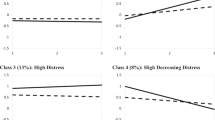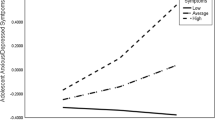Abstract
The present study analyzes the mental-health consequences of stress in a sample of 1,038 adolescents (526 females and 512 males) from a Canadian prairie city. The study examined the relationship between perceived stress in family, school, and peer-group situations and four measures of psychological well-being, i.e., anxiety, depression, social dysfunction, and anergia. The moderator effects of locus of control orientation (mastery) on stress-outcome relationships were also examined, as were the sex differences in health and the perception of stress. All three sources of stress were found to be related to the four measures of mental health, with family stress having the strongest negative health impact. The health-protective role of locus of control was limited for the large part to the stresses emanating from school and peer groups. Substantial sex differences were found in the perception of family- and peer-related stresses as well as in levels of psychological distress. A tentative explanation of these differences was examined with reference to prevailing structural conditions and differences in locus of control orientation, with female adolescents showing greater externality. Implications of the results are drawn for the long-standing debate on the relative impact of stress and its sources on adolescents' psychosocial development and for a current controversy in adolescent theory between proponents of “classical” and proponents of “empirical” conceptions of adolescence.
Similar content being viewed by others
References
Abdel-Halim, A. A. (1980). Effects of person-job compatibility on managerial reactions to role ambiguity.Organiz. Behav. Hum. Perform. 26: 193–211.
Ackerman, N. W. (1962). Adolescent problems: A symptom of family disorder.Family Proc. 1: 202–213.
Bandura, A. (1972). The stormy decade: Fact or fiction? In Rogers, D. (ed.)Issues in Adolescent Psychology, 2nd ed., Appleton-Century-Crofts, New York.
Banks, M. H. (1983). Validation of the General Health Questionnaire in a young community sample.Psychol. Med. 13: 349–353.
Bardwick, J. (1971).Psychology of Women, Harper and Row, New York.
Breton, R. (in collaboration with McDonald, J., and Richer, S.) (1972).Social and Academic Factors in the Career Decisions of Canadian Youth, Department of Manpower and Immigration, Information Canada, Ottawa.
Brittain, C. V. (1963). Adolescent choices and parent-peer cross pressures.Am. Sociol. Rev. 28: 385–391.
Burke, R. J., and Weir, T. (1978). Sex differences in adolescent life stress, social support, and well-being.J. Psychol. 98: 277–288.
Coleman, J. S. (1961).The Adolescent Society, Free Press of Glencoe, New York.
Coleman, J. C. (1978). Current contradictions in adolescent theory.J. Youth Adoles. 7: 1–11.
D'Arcy, C. (1982). Prevalence and correlates of nonpsychotic psychiatric symptoms in the general population.Can. J. Psychiat. 27: 316–324.
D'Arcy, C., and Siddique, C. M. (1984). Psychological distress among Canadian adolescents.Psychol. Med. 14: 615–628.
Dohrenwend, B. S., and Dohrenwend, B. P. (eds.) (1974).Stressful Life Events: Their Nature and Effects, Wiley and Sons, New York.
Dohrenwend, B. P., Dohrenwend, B. S., Gould, M. S., Link, B., Neugebauer, R., and Wunsch-Hitzig, R. (1980).Mental Illness in the United States: Epidemiological Estimates, Praeger, New York.
Douvan, E., and Adelson, J. (1966).The Adolescent Experience, Wiley, New York.
Eichler, M. (1983).Families in Canada Today, Gage, Toronto, Ontario.
Elkin, F., and Westley, W. A. (1955). The myth of the adolescent peer culture.Am. Sociol. Rev. 20: 680–684.
Elkin, F., and Handel, G. (1978).The Child and Society: The Process of Socialization, Random House, New York.
Epperson, D. C. (1964). A re-assessment of indices of parental influence inThe Adolescent Society.Am. Sociol. Rev. 29: 93–96.
Epstein, C. (1970).Women's Place, University of California Press, Berkeley and Los Angeles.
Erickson, E. (1968).Identity, Youth and Crisis, Norton, New York.
Finlay-Jones, R. D., and Murphy, E. (1979). Severity of psychiatric disorder and the 30-item General Health Questionnaire.Br. J. Psychiat. 134: 609–616.
Freud, A. (1952). Adolescence.Psychoanal. Stud. Child. 13: 255–278.
Glynn, T. J. (1981). From family to peer: A review of transitions of influence among drug-using youth.J. Youth Adoles. 10: 363–377.
Goldberg, D. (1978).Manual of the General Health Questionnaire, NFER, Windsor, Birks, England.
Gove, W. R. (1978). Sex differences in mental illness among adult men and women: An evaluation of the evidence on the higher rates of women.Soc. Sci. Med. 12B: 187–198.
Gove, W. R., and Herb, T. R. (1974). Stress and mental illness among the young: A comparison of the sexes.Soc. Forces 53: 256–265.
Graham, P., and Rutter, M. (1973). Psychiatric disorder in the young adolescent: A follow-up study.Proc. Roy. Soc. Med. 66: 1226–1229.
Health and Welfare Canada (1983). Adolescents face stressful life changes.Health Educ. Fall: 8–12.
Henderson, S., Duncan-Jones, P., Byrne, D. G., and Adcock, S. (1979). Psychiatric disorder in Canberra: A standardized study of prevalence.Acta Psychiat. Scand. 60: 355–374.
Hobart, C. (1981). Sources of egalitarianism in young unmarried Canadians.Can. J. Sociol. 6: 261–282.
Ishwaran, K. (1979).Childhood and Adolescence in Canada, McGraw-Hill Ryerson, Toronto, Ontario.
Jahoda, M., and Warren, N. (1965). The myth of youth.Sociol. Educ. 38: 138–149.
James, W. H. (1963).The James I-E Scale, Library of Congress, Washington, D.C.
Jencks, C., Smith, M., Acland, H., Bane, M. J., Cohen, D., Cintis, H., Heyns, B., and Michelson, S. (1972).Inequality: A Reassessment of the Effects of Family and Schooling in America, Basic Books, New York.
Jenkins, R. (1980). Minor psychiatric morbidity in employed men and women and its contribution to sickness absence.Psychol. Med. 10: 751–757.
Joe, V. C. (1971). Review of the internal-external control construct as a personality variable.Psychol. Rep. 28: 619–640.
Johnson, J. H., and Sarason, I. G. (1978). Life stress, depression and anxiety: Internal-external control as a moderator variable.J. Psychosom. Res. 22: 205–208.
Keenan, A., and McBain, G. D. (1979). Effects of type A behavior, tolerance of ambiguity and locus of control on the relationships between role stress and work-related outcomes.J. Occupation. Psychol. 52: 277–285.
Larson, L. E. (1972). The influence of parents and peers during adolescence: The situation hypothesis revisited.J. Marriage Family. 34: 67–69.
Lazarus, R. S. (1966).Psychological Stress and the Coping Process, McGraw-Hill, New York.
Maccoby, E. (1966).The Development of Sex Differences, Stanford University Press, Palo Alto, Calif.
Maccoby, E., and Jacklin, H. J. (1974).The Psychology of Sex Differences, Stanford University Press, Palo Alto, Calif.
Mechanic, D. (1983). Adolescent health and illness behavior: Review of the literature and a new hypothesis for the study of stress.J. Hum. Stess 9: 4–13.
Meyerson, S. (ed.) (1975).Adolescence: The Crisis of Adjustment, George Allan Urwin, London.
Nott, P. H., and Cutts, S. (1982). Validation of the 30-item General Health Questionnaire in postpartum women.Psychol. Med. 12: 409–413.
Offer, D., and Offer, J. (1975).From Teenage to Young Manhood, Basic Books, New York.
Richer, S. (1979). Sex-role socialization and early schooling.Can. Rev. Sociol. Anthropol. 16: 195–205.
Rotter, J. G. (1966). Generalized expectancies for internal versus external control of reinforcement.Psychol. Monogr. 80: Whole No. 609.
Rutter, M. (1980a). School influences on children's behavior and developments: The 1979 Kenneth Blackfan Lecture, Children's Hospital Medical Center, Boston,Pediatrics 65: 208–220.
Rutter, M. (1980b).Changing Youth in a Changing Society, Harvard University Press, Cambridge, Mass.
Rutter, M., Graham, P., Chadwick, O. F. D., and Yule, W. (1976). Adolescent turmoil: Fact or fiction?J. Child Psychol. Psychiat. 17: 35–56.
Rutter, M., Maughan, B., Mortimore, P., Ouston, J., and Smith A. (1979).Fifteen Thousand Hours: Secondary School and Their Effects on Children, Open Books, London.
Susser, M. (1981). The epidemiology of life stress (Editorial).Psychol. Med. 11: 1–8.
Tanner, J. (1978). Youth culture and the Canadian high school: An empirical analysis,Can. J. Sociol. 3: 89–102.
Tarnopolsky, A., Hand, D. J., and McLean, E. R. (1979). Validity and uses of a screening questionnaire (GHQ) in the community.Bri. J. Psychiat. 134: 508–515.
Tennant, C. (1977). The General Health Questionnaire: A valid index of psychological impairment in Australian populations.Med. J. Austral. II: 392–394.
Author information
Authors and Affiliations
Additional information
The data analyzed in this paper were originally collected for a study entitled “The Quality of Student Life” carried out by the Applied Research Unit (J. A. Lischeron, principal investigator). Data collection was greatly facilitated by the cooperation of the Saskatoon Public Board of Education and the Saskatoon Catholic Board of Education. This access and cooperation are gratefully acknowledged. Further analysis and interpretation of study data have been facilitated by the Psychiatric Services Branch, Saskatchewan Health, and a career support award to Carl D'Arcy from Health and Welfare Canada. The interpretation of data and comments in this paper are solely those of the authors.
Rights and permissions
About this article
Cite this article
Siddique, C.M., D'Arcy, C. Adolescence, stress, and psychological well-being. J Youth Adolescence 13, 459–473 (1984). https://doi.org/10.1007/BF02088593
Received:
Accepted:
Issue Date:
DOI: https://doi.org/10.1007/BF02088593




